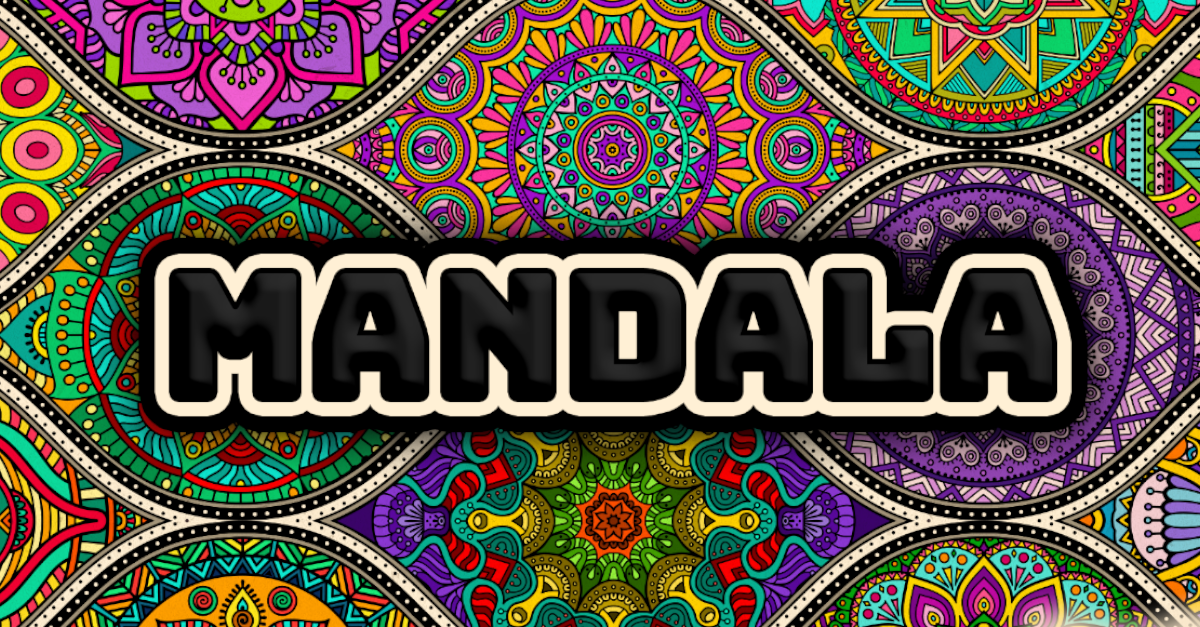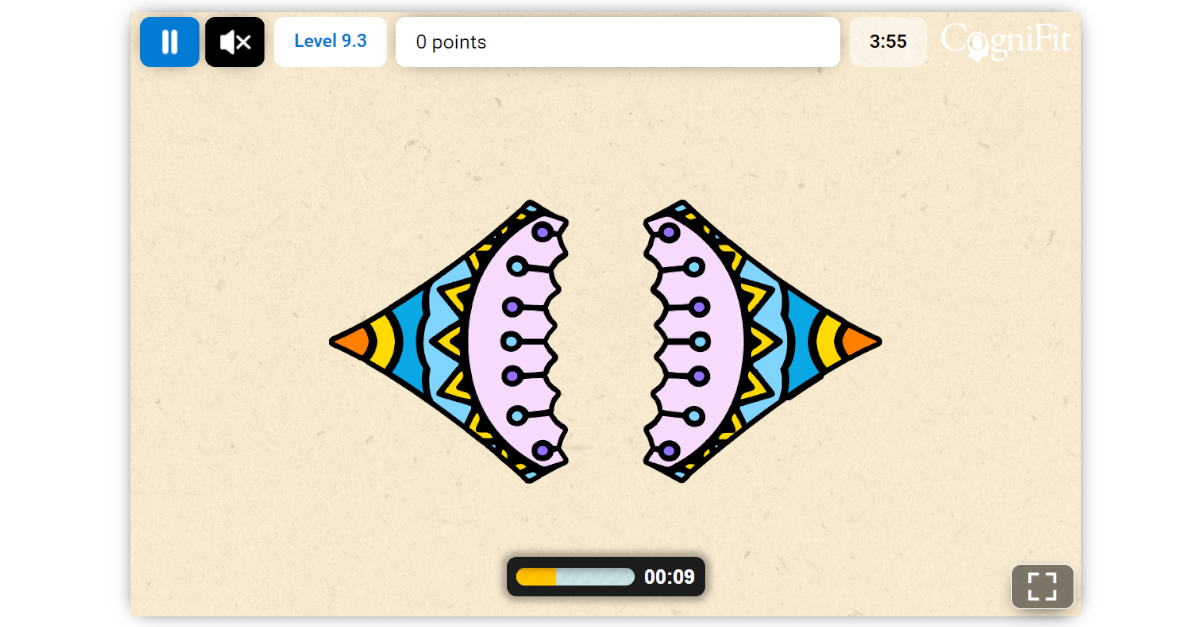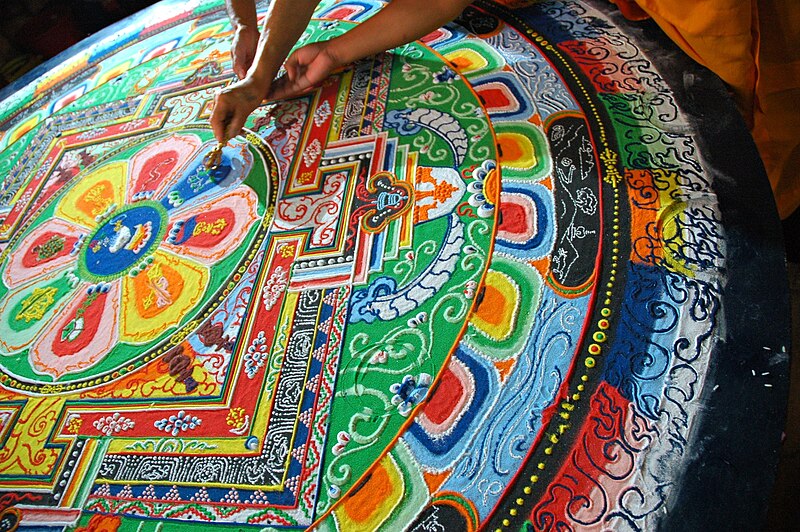
Mandala Game – Colors & Memory For Your Brain Games
Have you ever doodled while talking on the phone? How about colored in spaces of an agenda while you’re bored during a meeting? The desire to draw or color doesn’t go away just because we get older.
In fact, there are coloring books aimed at adults – all with the goal of helping someone nurture their creative side, combat stress, or just chill. And, after a quick internet search, you’ll also notice that one popular version is Mandala coloring books.
But here at CogniFit, we decided to take these beautiful images a step further. Our Mandala brain game will help stimulate three key brain functions while still letting you be creative!
Let’s take a look at how the game works, what brain functions you’ll exercise, and a brief history of the mandala and why it’s so popular.
What are the Mandala Brain Games?
At lower levels, things start off quite easy. You’ll be given a piece of a Mandala design, and all you have to do is click on the color palette on the left. Next, click the section of the design you want to fill in. You can even fill everything in one color if you want!
Also, if you don’t like what you’ve done, simply click on a new color and then select whatever part you wish to change. And don’t worry about the timer, there’s lots of room to play and experiment.
However, as the levels progress, things get trickier.

Instead of a free-range design, you’ll be shown a small section of a Mandala that is already colored in. A timer will count down and you need to memorize what colors go where. After, fill in the design as best you can. It could be something as simple as red versus blue. However, harder levels will make you change between different tints and shades of the same hue! Also, there is the occasional curveball where there are tiny sections that have been colored incorrectly.
A Quick Look at Its Beautiful Meaning & History

The word Mandala comes from Sanskrit for “circle” and holds a very deep meaning within Hindu and Buddhist cultures. They represent (externally) different aspects of the universe and are used (internally) as instruments of meditation and symbols of prayer. They found their way out of the East through people traveling the Silk Road.
Some amazing examples are made by monks – who spend weeks or months laying down grains of sand. After the design is complete, they destroy it (under the idea that nothing in the universe is permanent).
However, the modern use in “coloring books” has been found to be therapeutic because of their geometric designs. Recognizable objects (like cars or cartoon characters) come with subconscious expectations to make them “perfect” like the real thing. Coloring a Cinderella pumpkin in a scribbly blue could actually cause spikes of anxiety in some people.
Since a Mandal is just a collection of shapes, there is no right or wrong how to color the image. It frees the person from perfectionism benchmarks. It allows them to be creative and shed a certain level of anxiety because they are “present” in that moment. And, as we know, being present (sometimes called medication) can be incredibly healing.
How Does the Mandala Game Help the Brain?
Our CogniFit experts have tweaked this coloring exercise to help stimulate three important brain functions: Planning, Visual Perception, Visual Short-Term Memory. Let’s take a closer look at each of these and how they are used in our everyday lives.
Planning
Planning is one of our “Executive Functions” and a fundamental part of our cognitive makeup.
Executive functions are the set of cognitive skills necessary for controlling and self-regulating your behavior. It allows you to establish, maintain, supervise, correct, and carry out a plan of action.
Planning basically helps us know what our goals are and then decide the necessary steps in order to reach that goal. A simple example would be the end of our grocery trip. Our goal is to pack our food into bags. But we also need to plan how we will put everything in. We not only want everything to fit, but we also don’t want anything to be damaged. This is why we do things like put the eggs and bread on the very top.
An advanced example would be saving for a house. We know we need a down payment (the end goal), but we also need to plan how we will budget our expenses and pinch pennies where necessary.

People with poor planning functions might have the following problems…
- Have trouble making decisions
- Can’t see the consequences of their actions
- Can’t foresee how much time something will take
- Difficulty prioritizing
- Easily forgetful or distracted
- Low productivity or trouble being creative
- Don’t handle surprises or changes well
- Adapt slower than others to new surroundings
As we can see, the idea of “planning” might sound like something simple and an ability everyone has. But the truth is that it’s a brain function that can be strong or ineffective – depending on the person.
Visual Perception
You’re reading this text right now, and it seems like a breeze. But the truth is there are SO many processes going on in your brain to make this happen.
- First, the light hits our pupils and activates cells in our retinas
- Next, the signals travel up the optic nerve and then do a criss-cross in our brain hemispheres
- Finally, the information is sent to our visual cortex in the occipital lobe
- This isn’t even touching on the fact we need to distinguish things like color, shape, size, space, relationship, etc.
This is obviously a watered-down version of what really goes on. So, if you want to learn more, you can check out this page.
There is a slew of issues that can come from having poor visual perception. But one example is Visual Agnosia. The two versions of this will have someone be able to understand the parts of an object, but not the whole – or vice versa.
Visual Short-Term Memory
VSTM is part of our Short-Term Memory (STM). Our brains take in what we see during a short period of time and then it can either go into Working Memory, Long-Term Memory, or just forgotten.
A super-simple example would be reading a new word while studying a second language, versus learning it by hearing it through a recording. However, it’s a brain function that we use in every part of our lives.
Some issues that come from impaired or damaged Visual Short-Term Memory can include Alzheimer’s or dyslexia. Some people who have suffered a stroke might also find this part of their brain altered.
The Brain Can Be Strengthened
All this information about what can happen to our brains can sound kind of scary. But don’t worry! Everyone has strengths and weaknesses when it comes to our minds. Also, the great news is that these functions can be exercised to become stronger – which is where the Mandala game comes into play!
Closing – The Mandala Game
Mandala is another of CogniFit’s fun games to help you strengthen your neural network. And with its different levels of difficulty, anyone can choose what levels best suit their comfort zones or needs. It’s definitely a game worth adding to your weekly routine!












